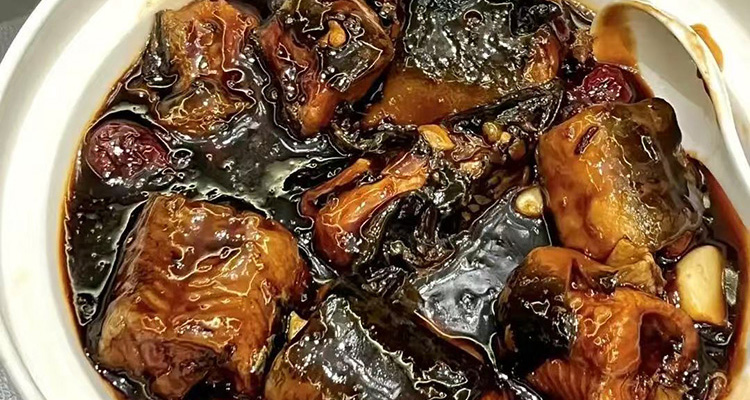Shanghai’s Famous Stewed Black Carp Liver
In Shanghai’s rich culinary landscape, benbang (local Shanghai) cuisine stands out for its glossy sauces, mellow umami, and comforting richness. Among its classics is a deceptively simple yet painstakingly crafted dish: stewed black carp liver. More than a flavor, it’s a living food memory of old Shanghai—an essential experience for travelers seeking the city’s authentic taste.
A humble origin that became legendary
This dish was born in the 1920s at Shanghai Old Restaurant (formerly Rongshunguan), where chef Yang Hesheng refused to waste the valuable fish livers discarded during busy service. He experimented with traditional benbang techniques and transformed these neglected livers into a golden, silky delicacy. Locals called it “tupai” — literally “bald lung” in Shanghainese, because “liver” was colloquially referred to as “lung” and the simple presentation emphasized the pure liver without many adornments. From frugality to fame, stewed black carp liver soon came to personify benbang’s principle of turning coarse ingredients into refined dishes.
Why the ingredient is so precious
The dish’s rarity comes from the ingredient and its seasonality. It uses the liver of the local black carp (qingyu), a large freshwater fish whose liver is fat, smooth, and richly flavored. Only livers from mature fish—typically five jin (about 2.5 kg) or larger—have the right texture and depth. Gathering enough liver for a single plate often requires several sizable fish, and the livers are at their best in autumn and winter, when the fish are fattest and flavor accumulates. Outside this season, the taste drops off, which is why the dish is prized and often costly.

The craft behind the silk
Making stewed black carp liver is a test of technique and patience. Fresh livers are fragile: removing connective tissue and the gall bladder without tearing or leaving any bitter residue is critical. Cleaning must remove fishiness while keeping the liver intact. After careful trimming, whole liver pieces are briefly blanched to set their shape, then slowly braised.
Benbang cooking favors “natural thickening”: instead of starch-thickened sauces, the chef relies on precise heat to coax the liver’s natural gelatin into a glossy, clingy sauce. Seasonings are simple but balanced—Shaoxing wine, light and dark soy, sugar, and slices of ginger—braised over low heat so the flavors sink into every pore. The process demands constant attention: one moment too hot or too rough a stir will break the liver. The goal is a golden-brown, lacquered finish and a sauce that clings seductively to the spoon.
An unforgettable taste experience
When the dish arrives, its shine and aroma already promise richness. A small spoonful reveals the magic: the liver’s texture is silky and melts almost without chewing—lighter than foie gras yet equally luxurious. The flavor is a powerful, layered umami—full, round, and lingering—without any fishy edge. The sweetness from the braise, the fragrance of Shaoxing wine, and the liver’s own buttery depth combine into a concentrated taste that many Shanghainese colorfully describe as “so fresh your eyebrows fall off.” It’s intense, memorable, and indulgent in the best possible way.

How to enjoy it like a local
Stewed black carp liver is usually served in small bowls or cups as a centerpiece course, showing its prestige. The proper way to eat it is hot, spooning small bites and savoring the way it dissolves on the tongue. Because of its concentrated flavor, it’s often eaten on its own rather than with heavy side dishes. Some enthusiasts, however, like mixing a spoonful of the sauce into a bowl of plain steamed rice so each grain is coated—a decadent but beloved practice. Pairing it with warm Shaoxing wine is classic: the wine’s mellow acidity lifts the richness and refreshes the palate.
Where travelers can find it
For visitors hoping to taste authentic stewed black carp liver, look to long-established benbang restaurants that preserve traditional techniques. Famous old houses such as Shanghai Old Restaurant, De Xing Guan, and Lao Zheng Xing are good starting points. Remember that this dish is highly seasonal—best between October and February—and may require advance booking because of the labor and ingredient constraints. If it’s on the menu out of season, it may be frozen or less flavorful, so ask the staff about freshness when ordering.

A simplified home attempt
Reproducing the restaurant perfection at home is difficult, but enthusiasts can try a simplified version. Substitute large fresh fish livers or quality chicken or pork liver to practice handling and braising. Clean and trim, blanch briefly, then sauté with ginger and garlic. Add Shaoxing wine, light and dark soy, a touch of sugar, and simmer gently until the sauce reduces and glosses. Finish with a splash of black vinegar to balance the richness. While not identical to the original, a home version helps you appreciate the textures and techniques that make the authentic dish special.
A bite of Shanghai’s soul
Stewed black carp liver is more than a luxurious plate—it’s a story of resourceful chefs, seasonal bounty, and meticulous craft. It captures benbang cuisine’s essence: transforming humble beginnings into something exquisitely refined. On your next Shanghai visit, seek out this dish at a reputable old restaurant, taste it slowly, and let it become one of your most vivid culinary memories of the city.


